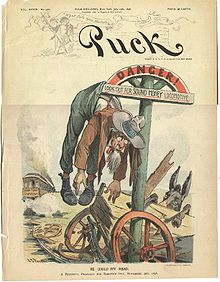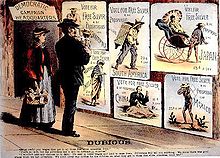Free silver
Free Silver (Free Silver), so the demand for free coinage of silver coins was a major policy dispute issues in the policy of the United States in the late 19th century. Proponents of free coinage advocated an expansive monetary policy . In contrast, there was support for the more precise control of the money supply by the gold standard . The supporters of a bimetallic monetary system made of gold and silver coins, called "Silberites", spoke out in favor of minting silver coins in a weight ratio of 16 to 1. The value of gold was much higher at that time, so most economists warned that under the Gresham-Copernican law, the less valuable silver coins would displace gold in payment transactions.
While everyone agreed that an increased supply of money would lead to a rise in prices, there was some dispute over whether or not this inflationary trend was useful. The dispute culminated between 1893 and 1896 when the economy went through a period of severe depression that was remembered as the " Panic of 1893 ". It was marked by marked deflation , high unemployment in the industrial areas and a great burden on farmers.
The debate saw the advocates of the gold standard in the northeast, mostly entrepreneurs from the railway construction and manufacturing sectors, as well as business people, all of whom benefited as lenders from the deflation and repayment in gold dollars. In the agricultural regions of the country, on the other hand, farmers saw more advantages in higher prices for their produce and in easier borrowing. "Free silver" was therefore particularly popular in the western Midlands and in cotton growing in the south. Then there were the silver mines of the west. Farmers in the northeast and corn belt were less fond of silver.
Free Silver was the main theme of the Democrats during the presidential election of 1896 and 1900 . Their leader, William Jennings Bryan , became famous with his Cross of Gold speech , with which he stood up for silver. The Populist Party also supported him in 1896. However, the electoral defeats meant that after 1896 the gold standard was accepted nationwide.
The dispute lasted ultimately until 1913, when the law of the Federal Reserve , the monetary system of the United States renewed principle.
Definitions
Under the gold standard, anyone could have their gold bars converted into gold coins. The purpose of the followers of free silver demanded the same for silver coins, although the face value of the coins was much higher than the value of the metal.
Seen in this way, the value of silver coins was based more on the value added by the government ( fiat money ). Free coinage would have led to an increase in the money supply and thus to inflation .
reaction

Many populist organizations were in favor of inflationary monetary policy as it would help to reduce the debt of farmers. The development was disadvantageous for creditors.
Climax
The Populist Party largely advocated Free Silver, it allied itself with the Democrats, which dissuaded them from advocating the gold standard. William Jennings Bryans , presidential candidate in 1896, was backed by the populists, Silver Republicans, and most of the Democrats.
Points of contention were silver, gold or paper money, which the greenbacks advocated as a third option. A fourth option, land funding , was advocated by Senator Leland Stanford but always rejected by the Senate Finance Committee.
Brotherhoods of Free Silver
Three brotherhoods grew in importance until the mid-1980s and supported their cause in the election campaign of 1896.
List of brotherhoods of Free Silver
- Freemen's Protective Silver Federation - Founded in Spokane, Washington in 1894 .
- Silver Knights of America - founded in 1895, disbanded after 1896.
- Patriots of America - Founded by William Harvey in 1895.
Results
The urban electorate, especially the German-Americans, rejected the silver currency because it would lead to higher prices, unemployment and economic crises. The mixed farms of agriculture in the Midwest and the East also opposed it, only the cotton plantations in the South and the wheat farmers in the West enthusiastically advocated silver. Bryan tried again in 1900 to put the issue on the agenda, but lost no more than before. When he dropped the subject, it was forgotten and could not be revived.
symbolism
Free Silver became more and more associated with populism , trade unions and the struggle of the common American against the banks, the monopolists of the railway construction and the robber barons of the golden age of capitalism. It was also called "People's Money" (in contrast to the gold standard, which the populists labeled as the money of exploitation and oppression). William H. Harvey's popular pamphlet Coin's Financial School, from the time after the panic of 1893, described the restorative properties of silver: the devaluation of money would reopen closed factories, the old chimneys would start smoking again, and so on. Henry Demarest Lloyd, on the other hand raged against it and wrote: "The free silver movement is a fake. Free silver is the cow-bird of the reform movement. It waited until the nest had been built by the sacrifices and labor of others, and then it lay its own eggs in it, pushing out the others which lie smashed on the ground. "
See also
literature
- Coletta, Paolo E. “Greenbackers, Goldbugs, and Silverites: Currency Reform and Politics, 1860-1897,” in Wayne Morgan, H. (ed.), The Gilded Age: A Reappraisal. Syracuse, NY: Syracuse University Press, 1963; pp. 111-139.
- Kazin, Michael. A Godly Hero: The Life of William Jennings Bryan (2007)
- Gram, Marshall. "The Free Silver Movement in America: A Reinterpretation," Journal of Economic History, vol. 64, no. 4 (Dec 2004), pp. 1108-1129.
- Knight, Gretchen. Goldbugs and Greenbacks: The Antimonopoly Tradition and the Politics of Finance in America. (1997)
- Rockoff, Hugh. "The 'Wizard of Oz' as a monetary allegory," Journal of Political Economy, vol. 98, no. 4 (Aug. 1990), pp. 739-60 in JSTOR
- Wells, Wyatt. "Rhetoric of the Standards: The Debate over Gold and Silver in the 1890s," Journal of the Gilded Age and Progressive Era, (Jan. 2015) 14 # 1 pp. 49-68.
- Williams, R. Hal. Realigning America: McKinley, Bryan, and the Remarkable Election of 1896. Lawrence, KS: University Press of Kansas, 2010.
Web links
- The Money Question of the 51st Congress : Speeches to the 51st Congress (1889-1891)
- The Money Question of the 52nd Congress : Speeches before the 52nd Congress (1891-1893)
- The Money Question of the 53rd Congress : Speeches to the 53rd Congress (1893–1895) r
- Free silver cartoons by Judge
Individual evidence
- ^ Charles Hoffmann, "The Depression of the Nineties," Journal of Economic History (1956). Vol. 16, No. 2) 16 (2): 137-164. in JSTOR
- ^ Williams, 1910
- ^ Walter TK Nugent, Money and American Society, 1865-1880 (1968)
- ↑ Milton Friedman, "Bimetallism Revisited," Journal of Economic Perspectives Vol. 4, No. 4 (Autumn, 1990), pp. 85-104 in JSTOR
- ↑ Stevens, Albert C. The Cyclopædia of Fraternities; a compilation of existing authentic information and the results of original investigation as to more than six hundred secret societies in the United States New York city, Paterson, NJ, Hamilton printing and publishing company p.301
- ↑ Stevens, p.322
- ↑ Stevens, p.321
- ^ Russell L. Mahan, "William Jennings Bryan and the Presidential Campaign of 1896". White House Studies (2003). 3 (1): 41. doi: 10.2307 / 1917933 . JSTOR 1917933 .
- ^ The Populist Response to Industrial America p142 Norman Pollack - 1976 "This was followed by his blistering indictment of silver:" The Free Silver movement is a fake. Free Silver is the cow-bird of the Reform movement. "

